Multi-Layer Anti-Reflection Film Based on SiOx and NbOx by DC Pulse Sputter System with Inductively Coupled Plasma Source
Abstract
:1. Introduction
2. Materials and Methods
2.1. Materials
2.2. Characteristics
2.3. Fabrication of High-Quality Multi-Layers AR Film Based on SiOx and NbOx (M-SiNb)
3. Results
3.1. Characteristics of SiOx and NbOx Single Layer
3.2. Characteristics of the Multi-Layer AR Film Based on SiOx and NbOx (M-SiNb)
4. Conclusions
Author Contributions
Funding
Acknowledgments
Conflicts of Interest
References
- Kim, M.; Kang, T.W.; Kim, S.H.; Jang, E.H.; Park, H.H.; Seo, J.; Lee, S.J. Antireflective, self-cleaning and protective film by continuous sputtering of a plasma polymer on inorganic multilayer for perovskite solar cells application. Sol. Energy Mater. Sol. Cells 2019, 191, 55–61. [Google Scholar] [CrossRef]
- Castellón, E.; Zayat, M.; Levy, D. Sol-gel materials for electro-optical and optically active humidity-sensitive devices. J. Solgel Sci. Technol. 2019, 89, 56–61. [Google Scholar] [CrossRef]
- Ying, S.P.; Fu, H.K.; Hsieh, H.H.; Wu, J.H. Optical film design of low-glare LED panel light. Opt. Laser Technol. 2019, 111, 45–50. [Google Scholar] [CrossRef]
- Kim, J.; Song, S.; Kim, Y. A Basic Study on Anti-reflection Coating PV Technology for Reducing Reflected Sunlight on the Building Skin. Asia-pacific Journal of Convergent Research Interchange 2019, 5, 23–30. [Google Scholar] [CrossRef]
- Macleod, H.A. Thin-film Optical Filters, 5th ed.; CRC Press: Boca Raton, FL, USA, 2017; pp. 1–251. [Google Scholar]
- Kim, J.Y.; Han, Y.K.; Kim, E.R.; Suh, K.S. Two-layer hybrid anti-reflection film prepared on the plastic substrates. Curr. Appl. Phys. 2002, 2, 123–127. [Google Scholar] [CrossRef]
- Lee, J.H.; Jang, G.E.; Jun, Y.H. Investigation and evaluation of structural color of TiO2 coating on stainless steel. Ceram. Int. 2012, 38, S661–S664. [Google Scholar] [CrossRef]
- Jeong, S.H.; Kim, J.K.; Kim, B.S.; Shim, S.H.; Lee, B.T. Characterization of SiO2 and TiO2 films prepared using rf magnetron sputtering and their application to anti-reflection coating. Vacuum 2004, 76, 507–515. [Google Scholar] [CrossRef]
- Hassanien, A.S.; Akl, A.A. Optical characterizations and refractive index dispersion parameters of annealed TiO2 thin films synthesized by RF-sputtering technique at different flow rates of the reactive oxygen gas. Physica B Condens. Matter 2020, 576, 411718. [Google Scholar] [CrossRef]
- Coskun, Ö.D.; Demirela, S. The optical and structural properties of amorphous Nb2O5 thin films prepared by RF magnetron sputtering. Appl. Surf. Sci. 2013, 277, 35–39. [Google Scholar] [CrossRef]
- Xi, J.Q.; Kim, J.K.; Schubert, E.F.; Ye, D.; Lu, T.M.; Lin, S.Y.; Juneja, J.S. Very low-refractive-index optical thin films consisting of an array of SiO2 nanorods. Opt. lett. 2006, 31, 601–603. [Google Scholar] [CrossRef] [Green Version]
- Depla, D.; Mahieu, S. Reactive Sputter Deposition; Springer: Berlin, Germany, 2008; pp. 1–254. [Google Scholar]
- Wu, W.Y.; Chan, M.Y.; Chen, G.Z.; Liao, S.C.; Lee, C.H.; Lui, P.W. Structural properties of TiN thin films prepared by RF reactive magnetron sputtering. Surf. Coat. Technol. 2019, 362, 167–175. [Google Scholar] [CrossRef]
- Kwak, B.S.; Boyd, E.P.; Erbil, A. Metalorganic chemical vapor deposition of PbTiO3 thin films. Appl. phys. lett. 1988, 53, 1702–1704. [Google Scholar] [CrossRef]
- Ellmer, K.; Cebulla, R.; Wendt, R. Transparent and conducting ZnO (: Al) films deposited by simultaneous RF-and DC-excitation of a magnetron. Thin Solid Films 1998, 317, 413–416. [Google Scholar] [CrossRef]
- Meziani, T.; Colpo, P.; Rossi, F. Design of a magnetic-pole enhanced inductively coupled plasma source. Plasma Sources Sci. Technol. 2001, 10, 276–283. [Google Scholar] [CrossRef]
- Jiang, X.Z.; Li, W.L.; Wumaier, T.; Yao, H.B. Diagnostic study of argon and oxygen mixtures in dual-frequency capacitively coupled plasmas using quadrupole mass spectrometer. Chem. Phys. Lett. 2019, 730, 472–477. [Google Scholar] [CrossRef]
- Samukawa, S.; Sakamoto, K.; Ichiki, K. Generating high-efficiency neutral beams by using negative ions in an inductively coupled plasma source. J. Vac. Sci. Technol. A 2002, 20, 1566–1573. [Google Scholar] [CrossRef]
- Ashida, S.; Shim, M.R.; Lieberman, M.A. Measurements of pulsed-power modulated argon plasmas in an inductively coupled plasma source. J. Vac. Sci. Technol. A 1996, 14, 391–397. [Google Scholar] [CrossRef]
- Sukhinin, G.I.; Isupov, M.V.; Fedoseev, A.V.; Yudin, I.B. Development of a distributed ferromagnetic enhanced inductively coupled plasma source for plasma processing. J. Phys. Conf. Ser. 2019, 1243, 012004. [Google Scholar] [CrossRef]
- Vlassak, J.J.; Nix, W.D. A new bulge test technique for the determination of Young’s modulus and Poisson’s ratio of thin films. J. Mater. Res. 1992, 7, 3242–3249. [Google Scholar] [CrossRef] [Green Version]
- Cho, Y.; Parmar, N.S.; Nahm, S.; Choi, J.W. Essential Macleod Program (EMP) simulated fabrication of high quality Zn: SnO2/Ag/Zn: SnO2 multilayer transparent conducting electrode on flexible substrates. Ceram. Int. 2017, 43, 7216–7221. [Google Scholar] [CrossRef]
- Oliveira, J.C.; Cavaleiro, A.; Brett, C.M. Influence of sputtering conditions on corrosion of sputtered W–Ti–N thin film hard coatings: Salt spray tests and image analysis. Corros. Sci. 2000, 42, 1881–1895. [Google Scholar] [CrossRef]
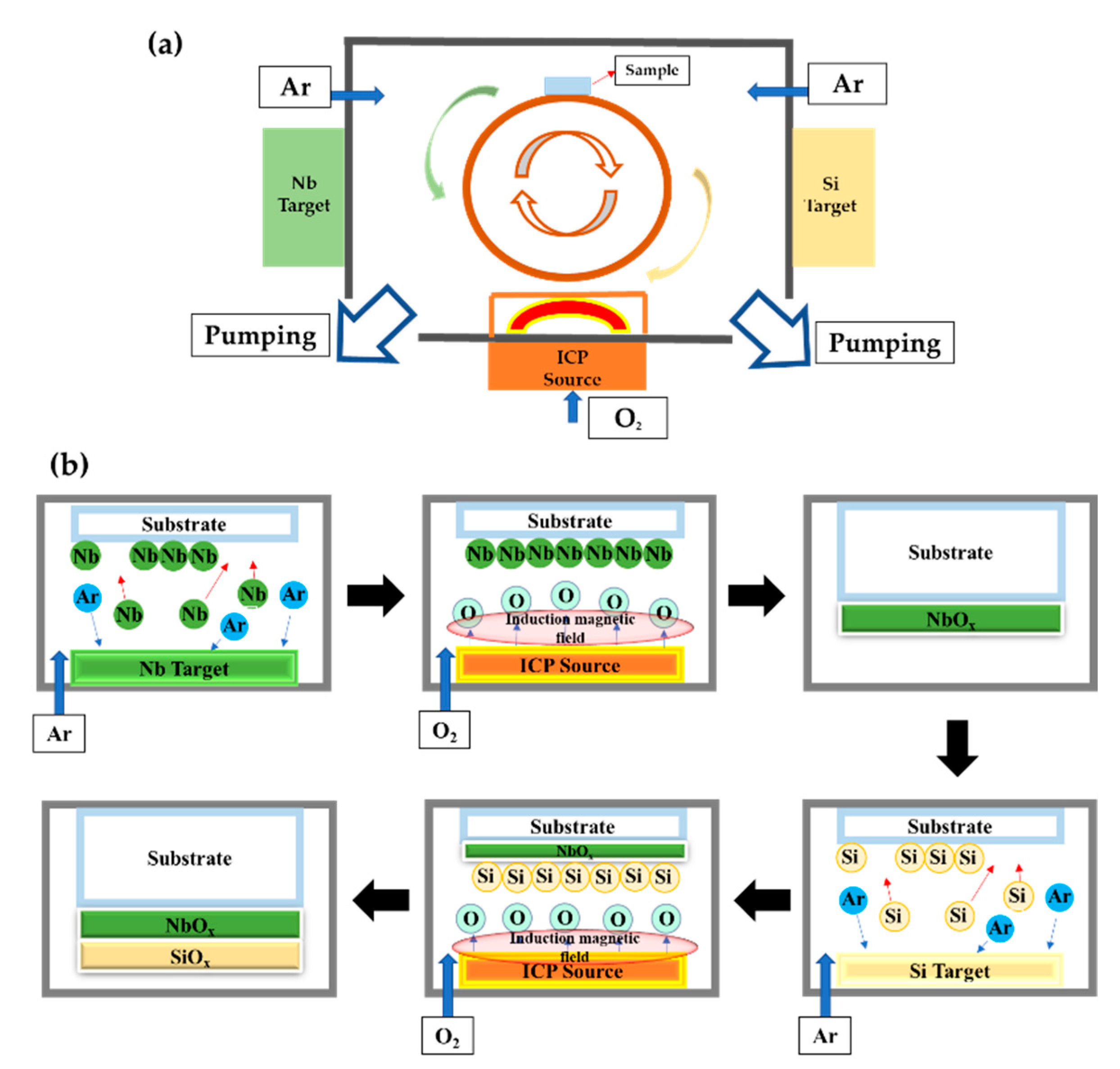

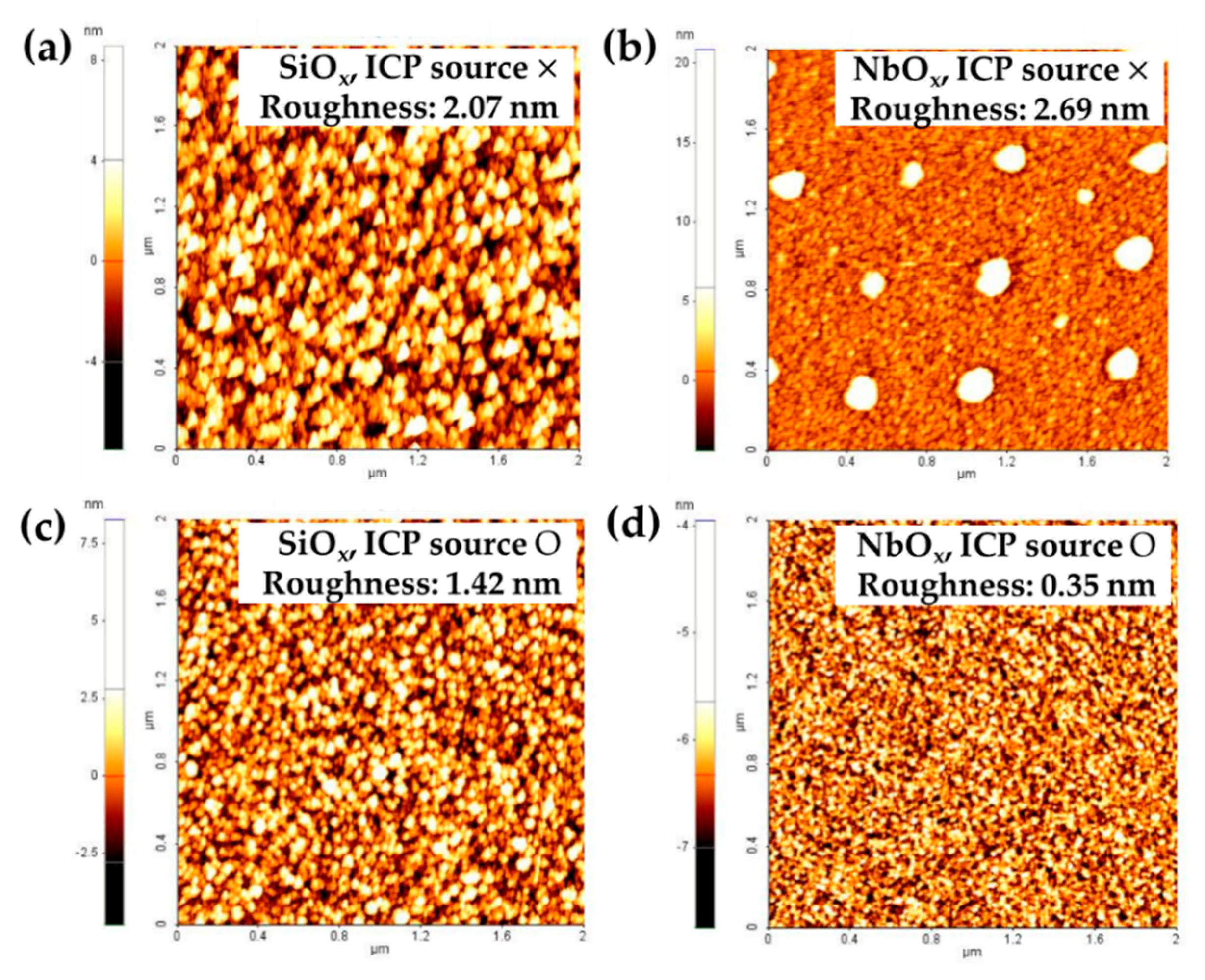
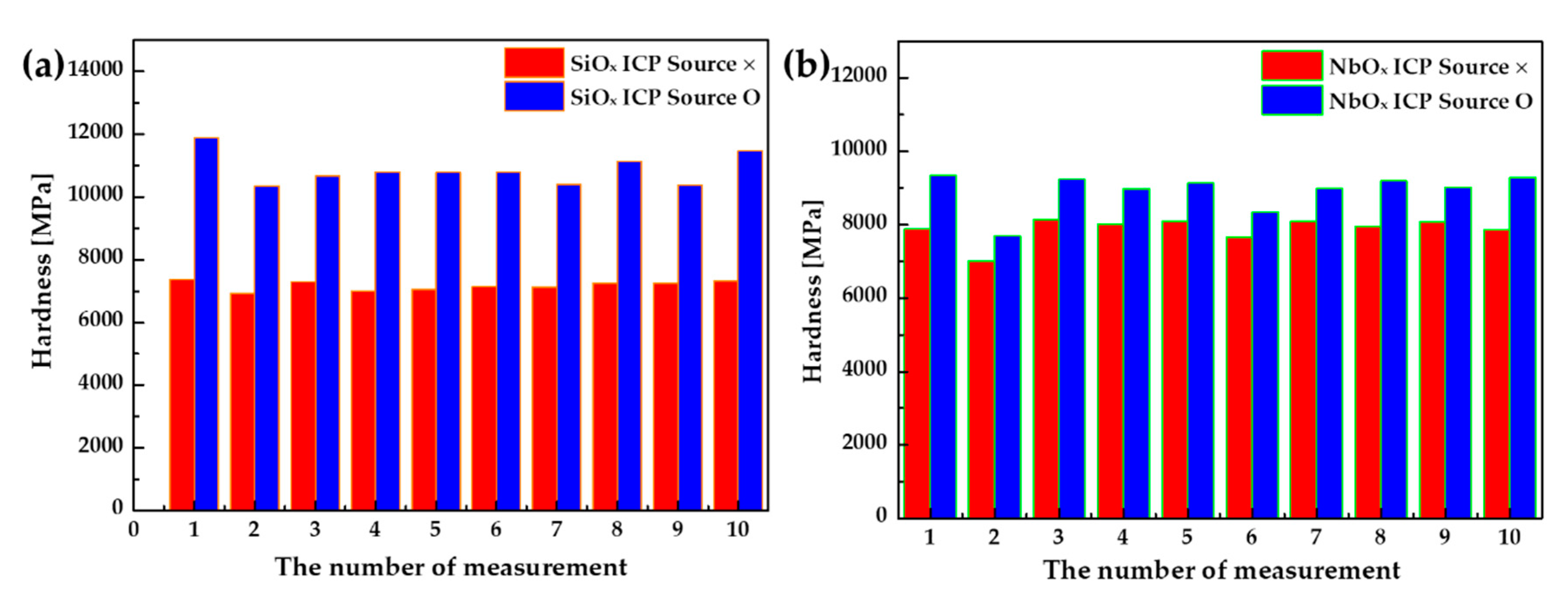

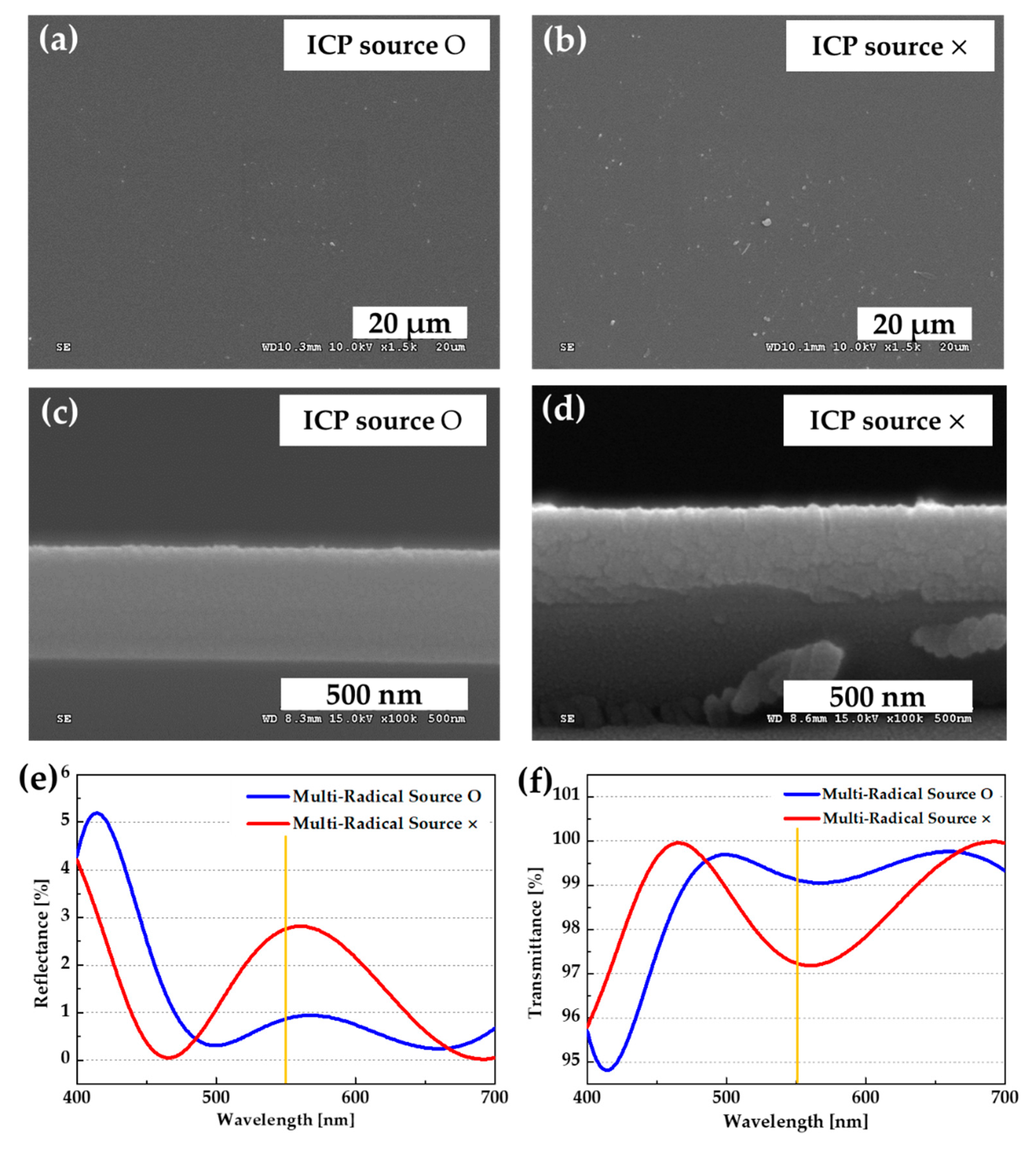
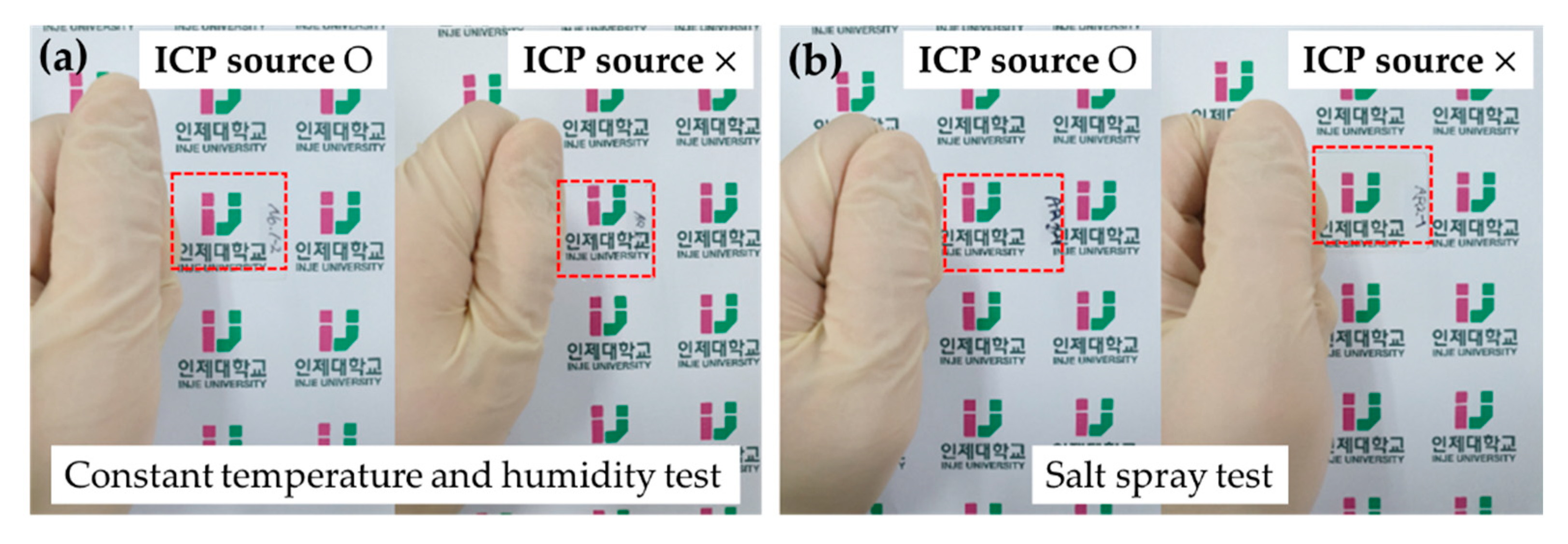


© 2020 by the authors. Licensee MDPI, Basel, Switzerland. This article is an open access article distributed under the terms and conditions of the Creative Commons Attribution (CC BY) license (http://creativecommons.org/licenses/by/4.0/).
Share and Cite
Lee, H.; Park, M.; Jeon, M.; Kim, B. Multi-Layer Anti-Reflection Film Based on SiOx and NbOx by DC Pulse Sputter System with Inductively Coupled Plasma Source. Crystals 2020, 10, 424. https://doi.org/10.3390/cryst10060424
Lee H, Park M, Jeon M, Kim B. Multi-Layer Anti-Reflection Film Based on SiOx and NbOx by DC Pulse Sputter System with Inductively Coupled Plasma Source. Crystals. 2020; 10(6):424. https://doi.org/10.3390/cryst10060424
Chicago/Turabian StyleLee, Hanbin, Minjeong Park, Minhyon Jeon, and Byeongcheol Kim. 2020. "Multi-Layer Anti-Reflection Film Based on SiOx and NbOx by DC Pulse Sputter System with Inductively Coupled Plasma Source" Crystals 10, no. 6: 424. https://doi.org/10.3390/cryst10060424




